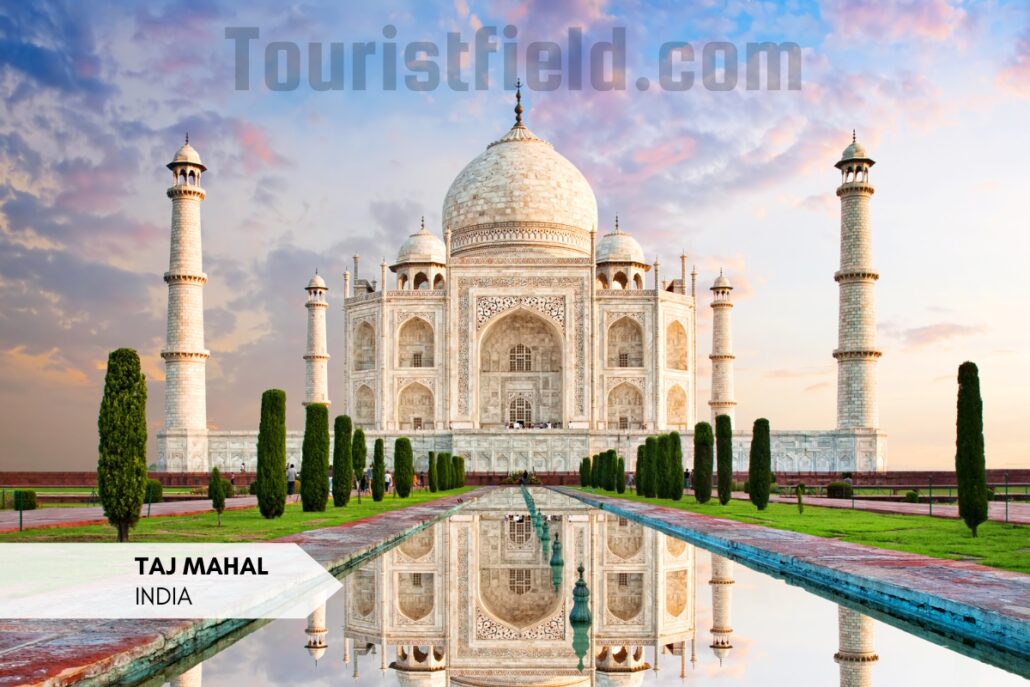Discover the Unmatched Majesty of the Taj Mahal:
The Taj Mahal, a symbol of love and architectural brilliance, is located on the south bank of the Yamuna River in Agra, India. Built-in 1632 by Mughal Emperor Shah Jahan as a tribute to his beloved wife Mumtaz Mahal, this iconic white marble mausoleum represents timeless love and stands as a masterpiece of Mughal architecture. Designated a UNESCO World Heritage Site in 1983, the Taj Mahal attracts millions of visitors annually from all over the world, making it one of the most admired tourist destinations worldwide.
History and Significance of the Taj Mahal
The Taj Mahal’s history is steeped in romance and tragedy. Shah Jahan, devastated by the death of Mumtaz Mahal during childbirth, vowed to build the most beautiful monument in the world in her honor. The construction of the Taj Mahal took 22 years, employing over 20,000 artisans, and is a testament to the skill and artistry of its time. The mausoleum’s design blends Persian, Islamic, and Indian architectural styles, creating a harmonious and visually stunning structure. Location:
The Symbolism Behind the Taj Mahal’s Design
Every element of the Taj Mahal’s design carries symbolic meaning. The perfectly symmetrical layout represents the concept of paradise in Islam, with the main mausoleum symbolizing the throne of God. The central dome, surrounded by four smaller domes, represents the heavenly vault. The use of white marble signifies purity and the changing hues throughout the day reflect the changing moods of the emperor and the empress.
Key Attractions within the Taj Mahal Complex
The Main Mausoleum
The main mausoleum is the centerpiece of the Taj Mahal complex. Built entirely of white marble, it houses the cenotaphs of Shah Jahan and Mumtaz Mahal. The intricate carvings, inlaid with semi-precious stones, and the delicate latticework are a testament to the artisans’ skill. The interior of the mausoleum is equally impressive, with detailed calligraphy and floral motifs adorning the walls.
The Charbagh Garden
The Taj Mahal is set within a vast 17-hectare Charbagh garden, a traditional Persian-style garden divided into four parts. This garden represents the Islamic idea of paradise, with its lush greenery, flowing water, and symmetrical layout. The garden’s four rivers symbolize the four rivers of paradise mentioned in the Quran, and the reflection of the Taj Mahal in the central pool creates a breathtakingly serene image.
The Mosque and the Jawab
Flanking the main mausoleum are two red sandstone buildings: the mosque and the jawab (meaning “answer”), which provide balance and symmetry to the complex. The mosque, located to the west, is an active place of worship and faces Mecca. The jawab, located to the east, was built solely for architectural symmetry and is not used for religious purposes.
The Great Gate (Darwaza-i-Rauza)
The Great Gate, or Darwaza-i-Rauza, serves as the main entrance to the Taj Mahal complex. This grand structure, made of red sandstone, is adorned with intricate calligraphy from the Quran and symbolizes the entrance to paradise. The gate’s design is meant to gradually reveal the Taj Mahal as visitors approach, heightening the sense of awe and wonder.
The Minarets
The four minarets that frame the Taj Mahal are not merely decorative; they serve both an aesthetic and practical purpose. Standing at 40 meters tall, the minarets are slightly tilted outward to protect the main mausoleum in case of an earthquake. These elegant towers add to the monument’s grandeur and are a significant element of Islamic architecture.
Best Times to Visit the Taj Mahal
Sunrise and Sunset Views
The Taj Mahal Tourist Attractions is renowned for its beauty at sunrise and sunset when the changing light creates a stunning array of colors on the white marble. Early morning visits allow tourists to experience the monument in relative peace, while the soft glow of the setting sun offers a different, equally mesmerizing view.
Seasonal Considerations
The best time to visit the Taj Mahal is during the cooler months, from October to March. The weather during this period is pleasant, making it ideal for exploring the complex. Avoid visiting during the summer months (April to June), when temperatures can soar, making the experience less comfortable. The monsoon season (July to September) brings heavy rains, which may hinder your visit.
Practical Information for Visitors
Entrance Fees and Timings
The Taj Mahal is open to visitors every day except Fridays, from sunrise to sunset. Entrance fees vary for domestic and international tourists, with an additional charge for those wishing to visit the main mausoleum. It is advisable to purchase tickets in advance, especially during peak tourist seasons, to avoid long queues.
Dress Code and Conduct
As the Taj Mahal is a UNESCO World Heritage Site and a place of great cultural significance, visitors are expected to dress modestly. Comfortable walking shoes are recommended, as the complex is vast and requires a fair amount of walking. Photography is allowed in most areas, but be respectful of signs indicating restricted zones.
Guided Tours and Audio Guides
To fully appreciate the history and architecture of the Taj Mahal Tourist Attractions, consider hiring a licensed guide or using an audio guide. These resources provide in-depth information and interesting anecdotes that enhance the visitor experience. Guided tours are available in multiple languages.
Conclusion
The Taj Mahal, one of the most iconic landmarks in the world, is located in Agra, India. Besides the Taj Mahal itself, the surrounding area offers several other attractions that tourists often visit. Here’s a guide to some of the key attractions: The Taj Mahal is not just a monument but a masterpiece that continues to captivate millions with its timeless beauty and rich history. From its intricate architecture to its symbolic gardens, every aspect of the Taj Mahal is designed to reflect the grandeur and love that inspired its creation. Whether you visit at dawn, dusk, or any time in between, the Taj Mahal promises an unforgettable experience that will leave you in awe of its splendor.


Pingback: Taj Mahal Sunrise Tour | Agra India | Tourist Field